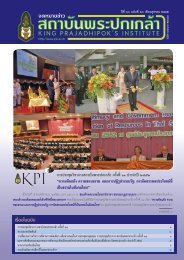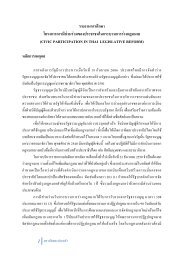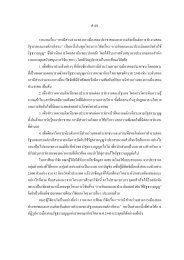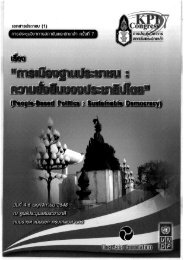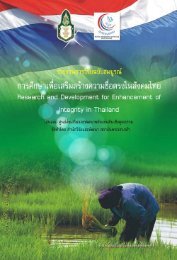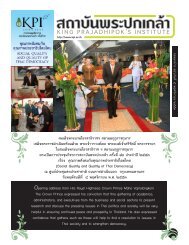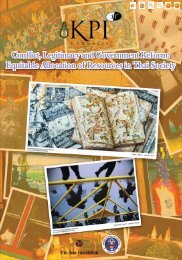SUFFiciENcy EcONOMy ANd GRASSROOtS DEvElOPMENt
SUFFiciENcy EcONOMy ANd GRASSROOtS DEvElOPMENt
SUFFiciENcy EcONOMy ANd GRASSROOtS DEvElOPMENt
Create successful ePaper yourself
Turn your PDF publications into a flip-book with our unique Google optimized e-Paper software.
206<br />
The Meaning of Sufficiency Economy <br />
International Conference<br />
be considered as activities that promote sufficiency. Punna ceremonies mean social<br />
events that call for the assistance of communities’ members in terms of labour,<br />
money and any other resources. According to Isaan tradition, the Twelve Traditions<br />
(Thai: ฮีตสิบสอง), the date of the full moon is the date for a Buddhist ceremony. The<br />
Twelve Traditions Punna ceremonies usually take place at local monasteries and are<br />
hosted by everyone in the village. Each month requires different food and objects or<br />
talisman to use in the ceremony. For example, rice-egg crackers are needed for the<br />
Punna ceremony of the second moon, the parade telling the story of a Bodhisattva (a<br />
compassionate higher being or Buddha-to-be) is needed for the fourth moon Punna<br />
ceremony and the big column of candle is made in the occasion of eighth moon<br />
Punna. Moreover, several Punna ceremonies apart from the Twelve Traditions,<br />
hosted by families, such as newborn cerebrations, weddings, ordinations and<br />
funerals could be observed. According to Isaan tradition, participating in Punna<br />
ceremonies is the expression of social cohesion. The one who misses several Punna<br />
ceremonies would be considered skeptical and could be disregarded from the<br />
community members. Therefore, Punna ceremonies can be considered as social<br />
events for its member to meet monks and practice Buddhist precepts, to confirm<br />
their community belonging, to share information and resources and to conserve<br />
traditional art and culture.<br />
While the economic aspect of the Survival domain explored the ability to<br />
produce commodities to save some money, the “Sufficiency” domain explored<br />
factors to ensure that the money is saved and spent mindfully.<br />
In conclusion, Sufficiency explored in the Inpaeng network is the ability to<br />
“think before spending and consuming”. To develop that ability, it involves the<br />
practice of mindfulness, the participation in religious ceremonies as chances to meet<br />
monks and chances to practice Buddhist precepts. Moreover, the locally appropriate<br />
financial organisation is also one of the factors to reinforce that ability. <br />
Sustainability<br />
Unlike Survival and Sufficiency, the domain of Sustainability is not the<br />
characteristics of an individual or a household; it is the attribute of the aggregated<br />
units. Sustainability concerns the characteristics of participants’ communities and<br />
their perceptions of those communities. Sustainability involves social engagement,<br />
social trust, environmental issues, the local natural resource management, and the<br />
perception to the young generation. <br />
Explored in rural communities, social groups can be categorised into several<br />
groups according to the objectives of those groups such as recreation groups,<br />
volunteer groups, financial groups, saving groups, religious groups, occupational<br />
groups, and administrative groups.<br />
Inpaeng network presents a variety of activities for its members to subscribe.<br />
Its activities range from administrative groups of Inpaeng trainers, Inpaeng<br />
administrators and staff to volunteer groups, local radio DJ groups, bush fire



